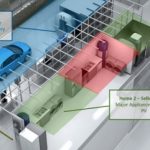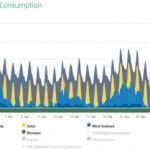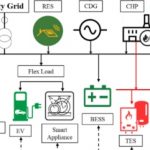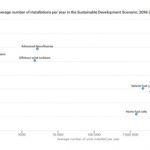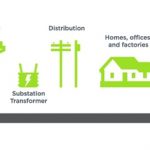Like many other sectors, the energy sector needs employees with digital skills. They need to create the new tools that can match power supply with demand, predict and detect faults in networks, and give greater control to consumers. It’s an essential part of the new world of decarbonisation, with digitalisation enabling the faster integration of renewables, improving grid stability and unlocking greater energy savings. Aloys Nghiem, Marc … [Read more...]
How to handle rapid Grid load growth: Data Centres can set the template for EVs, Buildings, new Industry
Due to their growing power demand, data centres can set a precedent for how to handle rapid load growth in a way that supports the grid and ensures reliable, resilient, carbon-free electricity. In other words, they can set the template for the coming surges in demand from EVs, buildings electrification, and the new rich-world policies of onshoring industry and manufacturing, explain Alexandra Gorin, Roberto Zanchi and Mark Dyson at RMI. Big, … [Read more...]
Europe’s grid bottlenecks are delaying its energy transition
***While you're here... REGISTER NOW for "REPowering the grid for Solar PV" with the Vice-President of Tauron, DG ENER C, Eurelectric and SolarPowerEurope - Online Wednesday September 20 from 11:00 to 12:15 CEST*** No amount of record sales and deployment in Europe of heat pumps, EVs, solar farms, wind turbines and all the rest will guarantee the region meeting its electrification targets if the grids aren’t ready to integrate them. As … [Read more...]
Event summary: “45% RES by 2030: EU’s latest investment challenge to DSOs”
Sara Stefanini provides a written summary of our panel discussion held on Thursday June 30th 2022. It’s a full summary of the 90 minute discussion (including audience questions), but it begins conveniently with a summary of the highlights. Investment in and the modernisation of the electricity distribution grid is one the biggest challenges the EU has to overcome in the next decade. It’s a €400bn investment challenge by 2050 says Eurelectric, an … [Read more...]
Event Summary: “CHINA: Carbon Neutral by 2060 – Innovation”
Here are the highlights of our 2-day 4-session workshop “CHINA: Carbon Neutral by 2060 - Innovation”, compiled by Sara Stefanini. It’s a quick and efficient way for readers to see the main points made by our expert panellists. Held at the end of May, it was the fourth of our EU-China workshops since the first was held in November 2020, produced for the EU China Energy Cooperation Platform (ECECP). As always, leading speakers from the EU, major … [Read more...]
Distributed Energy Resources and Smart Grids: an opportunity or a distraction?
Distributed Energy Resources (DERs) are poorly understood by the utilities, explain Doyob Kim and Alyssa Fischer at the IEA. Part of the problem is that new innovations and solutions are coming fast, and policy-makers aren’t creating the incentives and frameworks to make them an imperative. But, done right, the successful integration of DERs into the grid will accelerate electrification, address grid stability, and reduce spending on expensive … [Read more...]
Improving grid response to support climate targets and increased renewables [Energy Post event video]
We present our video of the online discussion from February 24, 2021 on smartgrid response. Digital, automated, data-driven smart response systems can play a key role in grid security and stability going forward. This makes asset monitoring and controllability - underpinned by the Smart Grid Indicator which is now part of the EU Electricity Directive (Article 59) - a vital link in the chain. Taking part were Vera Silva, COT, General Electric and … [Read more...]
Sweden’s new “prosumers”: electricity generation at the city, village and residential level
54% of Sweden’s power already comes from renewables – the target is 100% by 2040 - and more and more is being generated locally on a small distributed scale, says Harry Kretchmer writing for the World Economic Forum. ‘District Heating’ plants are today using excess heat to warm over 75% of Swedish homes. Residential generation is happening too, creating “prosumers” who both produce and consume. In Ludivika, 1970s flats have been retrofitted with … [Read more...]
Virtual blockchain for prosumers replicates a live utility-scale grid
Wayne Hicks at NREL describes research that’s created a virtual blockchain “prosumer” accounting system that replicates a live utility-scale grid. The goal of a real-world application is to allow countless individual households with their own electricity storage and generation to buy and sell power to each other; a truly revolutionary pathway. Clearly, it will require a system that securely accounts for vast amounts of transactions - a big enough … [Read more...]
Negative electricity prices: lockdown’s demand slump exposes inflexibility of German power
The lockdown has unexpectedly allowed us to model certain aspects of the energy sector’s possible future. One is the oversupply of variable renewables into the grid. In Germany, a slump in demand plus an exceptionally sunny and windy few months sent wholesale electricity prices negative and to record lows. Fossil generators calculated that paying buyers to take electricity was cheaper than performing a shut-down re-start sequence, so they did … [Read more...]
Beyond pilots: scaling up energy innovation in cities
Our current electricity grid was built hundreds of years ago, when power generation was centralised and our energy needs were far simpler. Electricity was distributed from large stable power plants to the consumers through a unidirectional flow that was easily predictable and did not require complex control. But over the last decades, cities have been going through a substantial change, seeing an exponential increase of their energy needs which … [Read more...]
Multi-energy “island” Microgrids can increase grid resilience
As the number of different technologies producing power and providing storage increases, the grid is getting complicated. The best way to make it resilient against outages is therefore changing. The traditional way is to shut down the failing plant, leaving the rest of the grid to cope as best as it can with the change in voltage and frequency. Xi Zhang at the Energy Futures Lab, Imperial College, describes the research looking at multi-energy … [Read more...]
CCUS, nuclear, industrial heat, hydrogen, smart grids: “large unit” innovation needs more support
How do we accelerate innovation across all technologies? Simon Bennett at the IEA breaks down the task into “small unit” and “large unit” challenges. The first is easier and moves faster. Thanks to their small size and unit cost, heat pumps, EVs and solar panels benefit from mass production, mass deployment (100,000 to 100m units/year globally) and large customer markets with fierce competition. They can also easily leverage other fast-evolving … [Read more...]
Non-Wires Alternatives for grid expansion: what the U.S. can teach Europe
Grid expansion usually means more power stations and wires. Far from simple, and very expensive. Non-Wires Alternatives (NWA) solve the problem differently by reducing net demand. Modern methods of energy efficiency, demand response, storage, and distributed generation are coordinated and used instead, under the banner of Distributed Energy Resources (DER). Crucially, it can cast utility firms in the role of market makers, not just generators and … [Read more...]
Grid balancing: Electric Cars are a lot like water heaters, so relax
Electric water heaters consume as much power as electric cars, drawing on the grid in much the same way: everyone’s doing it at roughly the same time of day. The U.S. already has 60m such heaters and manages to balance the grid with no problem. So adding tens of millions of electric cars should be very manageable even without direct control of when the cars charge, says Jim Lazar at the Regulatory Assistance Project (RAP). It only takes two to … [Read more...]










